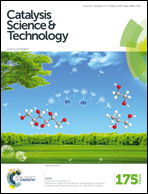Copper nanoparticles supported on diamond nanoparticles as a cost-effective and efficient catalyst for natural sunlight assisted Fenton reaction†
Abstract
A series of catalysts consisting of Cu nanoparticles (NPs) supported on diamond nanoparticles (D) were obtained by polyol reduction of Cu(NO3)2 in the presence of D. The best performing Cu/D catalyst was obtained using a D sample in which commercial D was subjected to Fenton treatment to decompose amorphous soot matter contaminating commercial D and subsequent hydrogen treatment at 500 °C to reduce oxygenated functional groups generated during oxidative treatment at the D surface. Cu/D performs better than analogous catalysts based on Cu NPs supported on activated carbon, carbon nanotubes and TiO2-P25. A comparison of the catalytic activity of Cu/D with that of analogous Au/D and Ag/D shows that although the catalytic activity of fresh Cu/D is somewhat lower, but comparable to the other two noble metal catalysts, the key issue is the lower Cu/D stability. The catalytic activity of Cu/D decreases upon reuse, although it can be recovered to a large extent by reducing again the catalyst using the polyol method before reuse. By Cu/D regeneration in each use, an accumulated turnover number of 52 600 was achieved.


 Please wait while we load your content...
Please wait while we load your content...